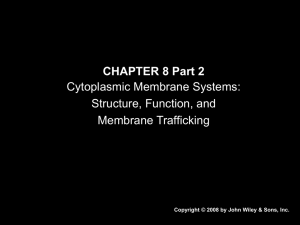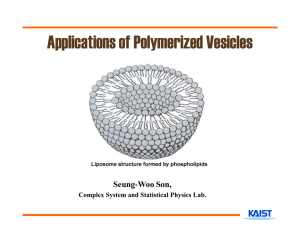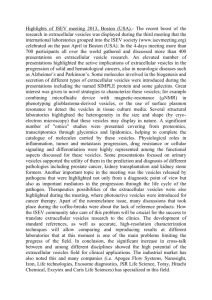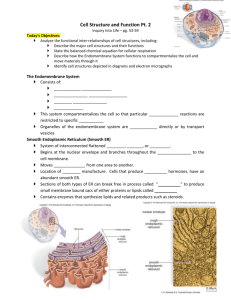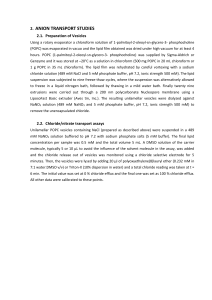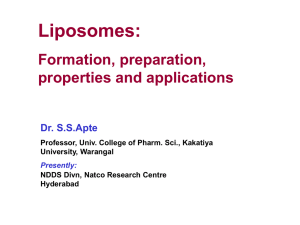Membrane-induced changes in the holomyoglobin tertiary structure
advertisement
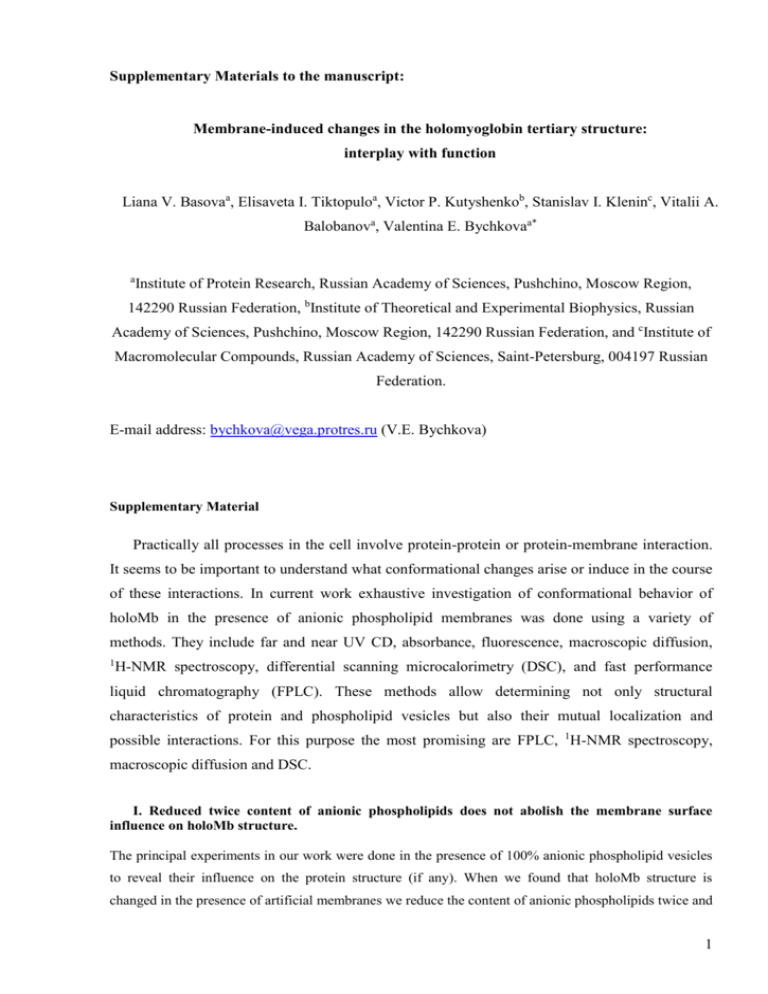
Supplementary Materials to the manuscript: Membrane-induced changes in the holomyoglobin tertiary structure: interplay with function Liana V. Basovaa, Elisaveta I. Tiktopuloa, Victor P. Kutyshenkob, Stanislav I. Kleninc, Vitalii A. Balobanova, Valentina E. Bychkovaa* a Institute of Protein Research, Russian Academy of Sciences, Pushchino, Moscow Region, 142290 Russian Federation, bInstitute of Theoretical and Experimental Biophysics, Russian Academy of Sciences, Pushchino, Moscow Region, 142290 Russian Federation, and cInstitute of Macromolecular Compounds, Russian Academy of Sciences, Saint-Petersburg, 004197 Russian Federation. E-mail address: bychkova@vega.protres.ru (V.E. Bychkova) Supplementary Material Practically all processes in the cell involve protein-protein or protein-membrane interaction. It seems to be important to understand what conformational changes arise or induce in the course of these interactions. In current work exhaustive investigation of conformational behavior of holoMb in the presence of anionic phospholipid membranes was done using a variety of methods. They include far and near UV CD, absorbance, fluorescence, macroscopic diffusion, 1 H-NMR spectroscopy, differential scanning microcalorimetry (DSC), and fast performance liquid chromatography (FPLC). These methods allow determining not only structural characteristics of protein and phospholipid vesicles but also their mutual localization and possible interactions. For this purpose the most promising are FPLC, 1H-NMR spectroscopy, macroscopic diffusion and DSC. I. Reduced twice content of anionic phospholipids does not abolish the membrane surface influence on holoMb structure. The principal experiments in our work were done in the presence of 100% anionic phospholipid vesicles to reveal their influence on the protein structure (if any). When we found that holoMb structure is changed in the presence of artificial membranes we reduce the content of anionic phospholipids twice and 1 then down to 30% using POPC lipids to keep constant the total concentration of lipids. We found that in this range (100%-30%) influence of anionic membrane surface on holoMb structure is very similar. Similar experiments were done earlier for apoMb (Balobanov et al. 2010). Representative experiments at 50% of anionic phospholipids are shown on Fig S1. Fig S1 The effect of mixed (POPC:POPG=50:50) vesicles on Trp fluorescence (A) and far UV CD spectra (B) of holoMb. A, 1 – POPG:holoMb=25:1, pH 7.2; 2 – (POPC/POPG):holoMb=25:1, pH 7.2, before melting; 3 – (POPC/POPG):holoMb=25:1, pH 7.2, after melting; N – holoMb without vesicles in 10 mM NaP buffer; B, 1 – (POPC/POPG):holoMb=25:1, pH 7.2, before melting; 2 – (POPC/POPG): holoMb=25:1, pH 7.2, after melting; N – holoMb without vesicles in 10 mM NaP buffer II. Heat melting of vesicles To study holoMb stability in the presence of artificial membranes we used two types of phospholipids: i) unsaturated POPG (melting temperature (Tm) is about -2OC) allow monitoring changes in protein melting; ii) saturated DPPG have Tm ≈ 40OC, and thus, it is possible to observe structural changes of phospholipid vesicles that occur in the presence of protein. For comparison, holoMb stability in the absence of vesicles was also determined. We carried out heat melting of holoMb in the presence of various amounts of POPG vesicles (Fig S2). As seen, even at the POPG:holoMb=25:1 molar ratio, the melting temperature of the protein is shifted towards lower temperature by about 20O, i.e., stability of the protein structure is decreased. Fig S2 also presents temperature dependence of holoMb heat absorption in the presence of vesicles at the DPPG:holoMb=50:1 molar ratio, pH 7.2 (S2B), as well as that of pure vesicles made from DPPG (S2C). As seen from Fig S2, there is no heat absorption peak of native holoMb 2 in the presence of POPG vesicles at a molar ratio higher than 50:1. Heat melting peak (Fig S2B), calculated per mole of phospholipids, is within the range of that for pure vesicles. The changes in shape of melting curve observed after second warming-up (after uncontrolled cooling) may reflect changes in phospholipids packing within vesicles that occur due to interaction of protein with the membrane surface; this supposition is underlain by the unchanged shape of melting curve for pure vesicles after second warming-up (Fig S2C) and by protein denaturation irreversibility in the presence of vesicles (Fig S2B). It should be recalled that heat melting of holoMb in solution without vesicles is reversible (Privalov et al. 1986). Fig S2 Temperature dependence of the excess heat capacity Cp,exc : A, for holoMb in the native state (1) at pH 6.2 and at 25:1 (2), POPG:holoMb=50:1 molar ratios, pH 7.2 (3); B, for DPPG vesicles with DPPG:holoMb=50:1 molar ratio at pH 7.2 (solid line) and their second heating (broken line); C, for pure DPPG vesicles without the protein at pH 7.2 (solid line) and their second melting (broken line) 3 It is clearly seen that even at the POPG:holoMb=25:1 ratio (curve 1), protein stability is dramatically decreased. The position of heat absorption peak for unbound protein molecules is shifted by about 20 0C towards lower values, in comparison with native protein, while at 50:1 (curve 2) and 200:1 (not shown), heat absorption peak has not been observed. At POPG:holoMb=25:1 molar ratio, not only melting temperature decreased, but also calorimetric enthalpy changed drastically. This may be explained by at least three reasons. First, the melting curve is produced only by a fraction of protein molecules. In fact, if we calculate enthalpy for a lower concentration, the peak will be larger but still shifted to lower temperatures. The second reason is that the protein structure is actually strongly destabilized in the presence of membranes. And third, the denatured state of holoMb becomes more stable in the presence of a denaturing agent, in our case – negatively charged phospholipid vesicles. We believe that destabilization of the tertiary structure is the most solid reason. Some evidence for that came from heat melting as dependent on ionic strength (see Fig 2). So, the negatively charged membrane surface of POPG vesicles affects the protein tertiary structure as a mild denaturant. III. Temperature dependence of the O2 release kinetics Temperature T is very important parameter for a conformational state of protein and its fluctuations. Thus, to study release of O2 at first we used room temperature 22OC. However, in a body the O2 delivery from oxyMb to mitochondria occurs at 37OC. Increase in temperature should increase fluctuations in tertiary structure and accelerate the release of O2 from oxyMb. Comparison of kinetics of O2 release at 22OC and 37OC is shown in Fig S3. 4 Fig S3 Release of O2 from oxyMb in the absence (22OC and 37OC) and in the presence (22OC and 37OC) of phospholipid vesicles. At 37OC it was used only POPG:MbO2=25:1 molar ratio, while at 22OC POPG:MbO2=25:1 and 100:1, pH 7.2. Details are shown in the field As it is seen from Fig S3, spontaneous release of O2 from oxyMb strongly depends on temperature. However at one and the same temperature addition of phospholipid vesicles substantially accelerates release of O2, but effect of temperature at the same molar ratio is much stronger. These kinetics clearly show that even at 37OC autooxydation of oxyMb is rather slow process, and in the body it certainly requires acceleration. From our point of view, one of the ways of acceleration of O 2 delivery to mitochondria from oxyMb may be the presence of the strongly negatively charged outer membrane of mitochondria. 5 Inset to Fig 10 Absorbance spectra of oxyMb: in the absence of phospholipid vesicles at the starting point (0 min, solid line) and after 210 min (long-dash line); in the presence of phospholipid vesicles (0 min after mixing, dash-dot line) and after 210 min (medium-dash line). B, time course of the metMb formation in the presence of anionic phospholipid vesicles at PL:P=25:1, 37oC, pH 7.2, monitored at 634 nm. 6
